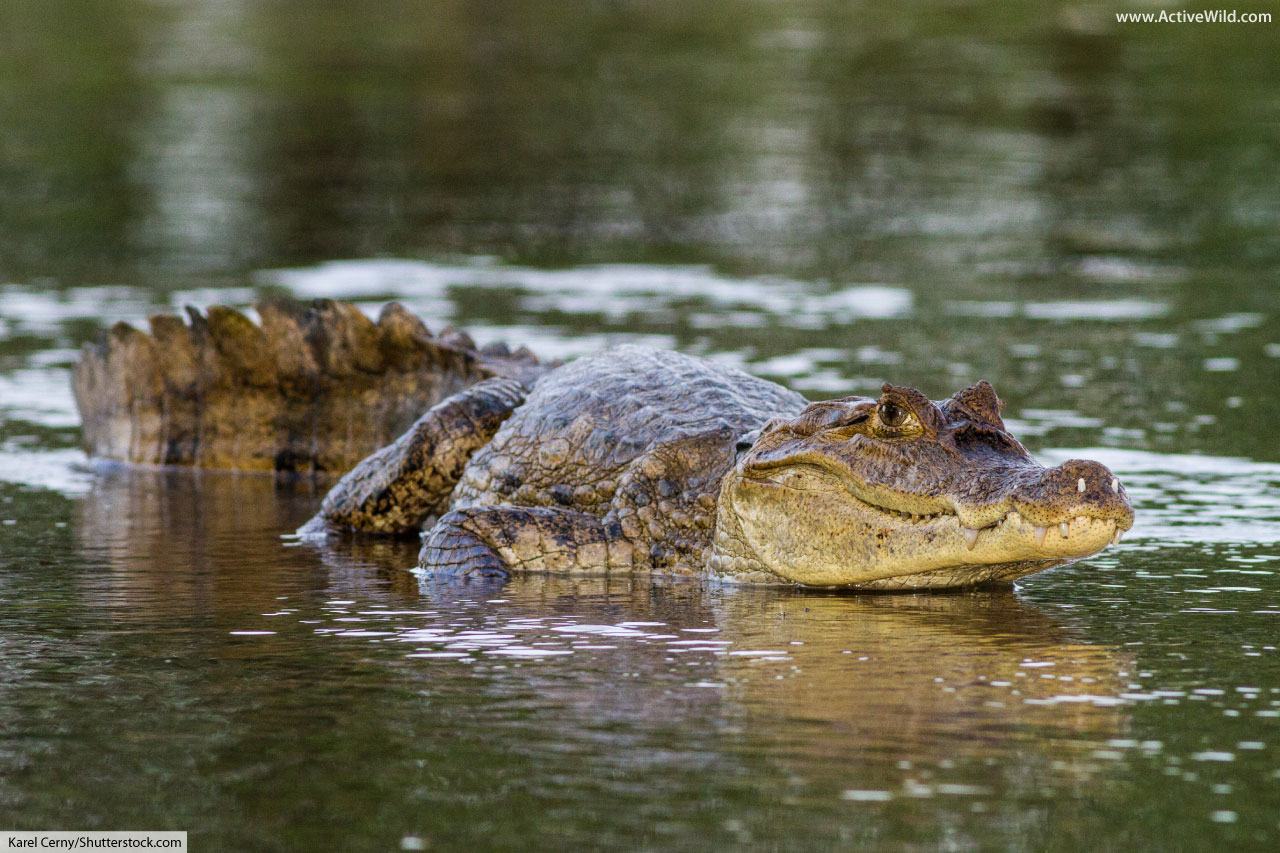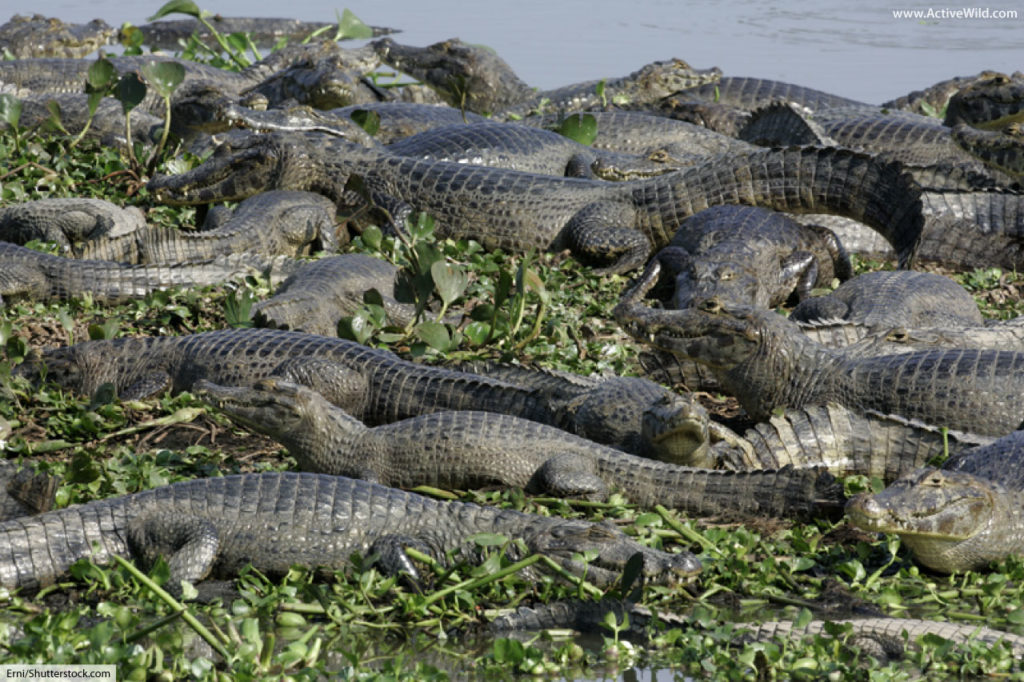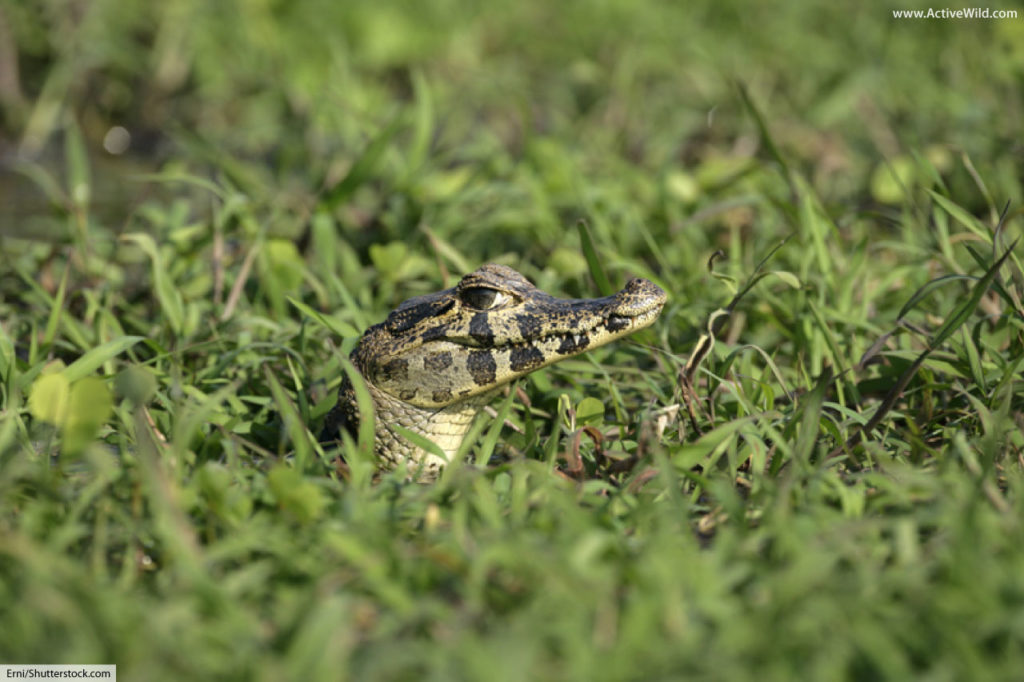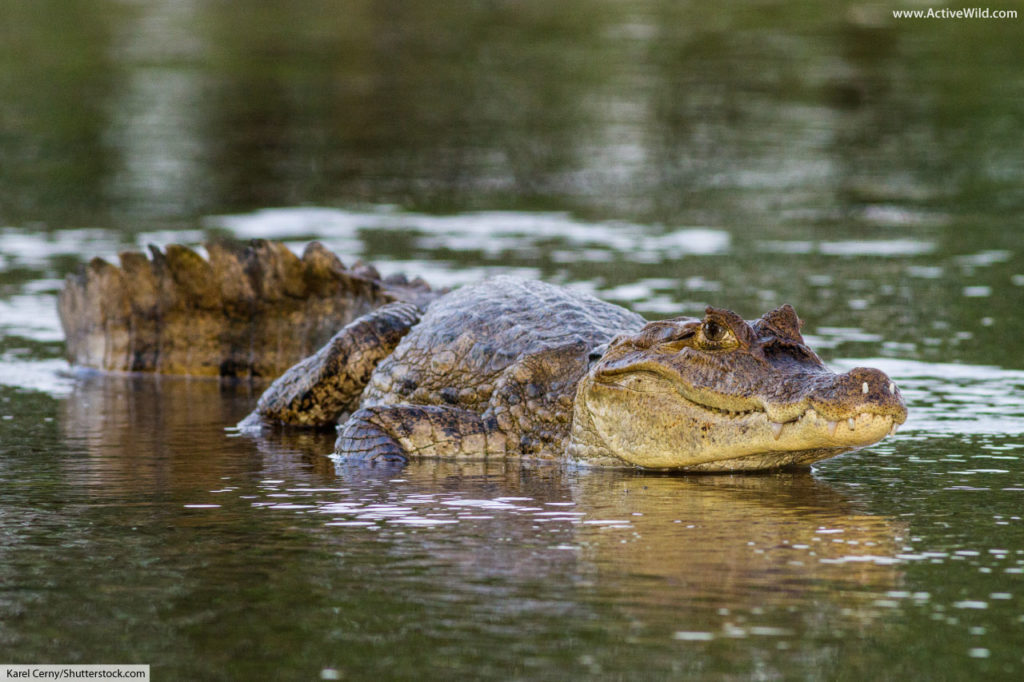Spectacled caiman facts for kids and adults, with pictures, video and in-depth information on behavior, diet and life-cycle. Discover a common crocodilian of Central and South America!
Spectacled Caiman Facts At A Glance
- Other Name(s): Common caiman, white caiman, brown caiman
- Scientific name: Caiman crocodilus
- Type of Animal: Reptile
- Animal Family: Alligatoridae
- Where Found: Central America, northern South America and the Caribbean
- Length: 8 to 2 m (5.9 to 6.6 ft.), male; 1.2 to 1.4 m (3.9 to 4.6 ft.), female
- Weight: 7 to 40 kg (15 to 88 lb.)
- Conservation Status: Least Concern
Other Interesting Spectacled Caiman Facts
- The species gets its name from the bony ridge between its eyes; this resembles a pair of spectacles.
- There are 3 subspecies (types) of spectacled caiman. They are differentiated by color, size and skull shape.
Spectacled Caiman
The spectacled caiman is a small to medium-sized crocodilian found in the Americas.
(Crocodilians are members of the order Crocodilia. This group of reptiles includes the ‘true’ crocodiles together with the caimans and alligators.)
- Baffled by terms such as 'order'? Check out our guide to animal classification and all will become clear!
Watch the video below to get an idea of what a spectacled caiman looks like ...
The spectacled caiman has a fairly broad, rounded snout. In addition to the spectacle-like ridge between the eyes, there is also a triangular ridge above each eye.
The species’ coloration varies between the three subspecies and also between different age ranges.
The skin of juveniles is typically a yellowish color and marked with darker blotches and bands. The color of mature individuals is typically grey-green, but can range from a dull orange to almost black. The markings of mature caimans are less pronounced than those of juveniles.
The spectacled caiman is also known to appear darker in cold weather. This is caused by the expansion of dark pigment contained within its skin cells.
Where is the Spectacled Caiman Found?
The spectacled caiman has the widest distribution range (i.e. the area in which it is found) of any crocodilian in the Americas.
The species is present in Central America, northern South America and parts of the Caribbean.
Spectacled Caiman Habitat
The spectacled caiman is typically found in humid tropical lowland regions. It has a higher tolerance to salt water than many other Crocodilians and is highly adaptable. This allows it to inhabit a wide variety of wetland ecosystems, including saltwater habitats such as estuarine lagoons.
The species tends to favor still water such as lakes, ponds and marshes but can also be found in slow-flowing rivers. It prefers habitats in which several different types of vegetation are present. The species may be found in both deep and shallow waters.
Spectacled Caiman Facts: Behavior
The spectacled caiman usually feeds at night. It is relatively inactive during the day, either basking on the shore to warm up or retreating to the water in order to escape the tropical heat.
(Like all reptiles, the spectacled caiman is ectothermic (cold-blooded). An ectotherm is unable to regulate its own body temperature, and is therefore reliant on its environment to attain the right temperature.)
In times of drought, the spectacled caiman may excavate a burrow in the mud into which it will retreat and enter a dormant state.
The species is generally solitary. Individuals usually stay within their home ranges throughout the year.
During the mating season the spectacled caiman becomes territorial and will aggressively defend its patch. During the dry season it is far more tolerant of other individuals and may occur in fairly dense concentrations.
Life Cycle
The spectacled caiman becomes sexually mature between 4 and 7 years of age. At this age females will have reached a size of around 1.2 m (3.9 ft.) and males 1.4 m (4.6 ft.).
The largest individuals are dominant over their smaller counterparts and have greater reproductive success.
The spectacled caiman mates between May and August; the timing is influenced by the local climate. Courtship behaviors include: swimming together, circling one other, rubbing backs, touching snouts, vocalizing and blowing bubbles.
Nest building usually occurs between July and November. The nest is constructed out of soil, leaf litter and other vegetation by the female. In the nest she will lay a clutch of 20 to 40 oval, hard-shelled eggs.
The incubation period is between 65 and 104 days. The decomposing vegetation provides insulation and protects the nest from sudden temperature changes.
As with many reptiles, the temperature inside the nest determines the sex of the hatchlings. Temperatures up to 31 °C (88 °F) produce male hatchlings; temperatures above 32 °C (90 °F) produce female hatchlings.
The female (aided, on occasion, by the male) guards the nest during the incubation period.
Shortly before hatching, the young begin to vocalize. The female responds to their calls by digging the nest open. She may also help the infants to hatch by breaking the shells open. She then carries the young to the water in her mouth.
The spectacled caiman provides parental care for a further 1.5 years. The young are often looked after in 'nursery groups' with a single female guarding not only her own young but also those of other spectacled caimans.
What Do Spectacled Caimans Eat?
The spectacled caiman is a carnivorous species whose diet consists of a wide range of vertebrates and invertebrates.
Juveniles typically feed on insects, shrimps, crabs and snails. The diet of adults additionally includes fish, amphibians, turtles, lizards and water birds. Larger individuals may also take mammals such as wild pigs and deer.
An ambush predator, the spectacled caiman typically waits for its victim to come within range of its powerful jaws before making an explosive lunge, capturing its victim in its jaws and dragging the unfortunate animal under the water with its heavy body. The species has also been observed trapping fish between its body and the shore.
Most feeding takes place during the wet season when prey is abundant. In particularly dry conditions when food is scarce, the spectacled caiman may resort to cannibalizing smaller individuals.
Spectacled Caiman Predators
Full grown spectacled caimans have few natural predators. However, their eggs are eaten by several animals, including tegu lizards, coatis and foxes. Juvenile caimans are preyed upon by other crocodilians, wading birds, large fish and snakes.
Is The Spectacled Caiman Endangered?
The spectacled caiman is not currently endangered; it is relatively common and rated 'Least Concern' by the IUCN.
The species is among the most widely-distributed crocodilians. Its population consists of around 1,000,000 individuals. However, local populations may find themselves threatened, and populations in countries such as Peru and El Salvador are declining. The subspecies C. c. apaporiensis is particularly vulnerable due to its highly restricted range.
The main threat to local spectacled caiman populations is illegal hunting. The animal is mainly hunted for its skin but in some areas its meat and eggs are also harvested.
Habitat destruction and pollution is also considered a potential threat in certain areas.
Spectacled Caiman Related Articles
- Discover the other types of caiman here: Caiman Facts
- Become a reptile expert: Reptiles: The Ultimate Guide
- Find out about the animal kingdom: Animals: The Ultimate Guide
- Discover amazing animals from all around the world: A to Z Animals





